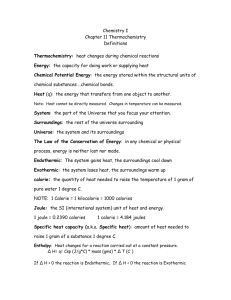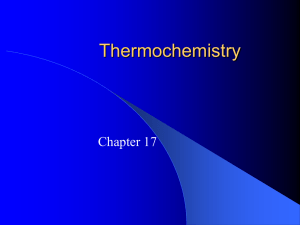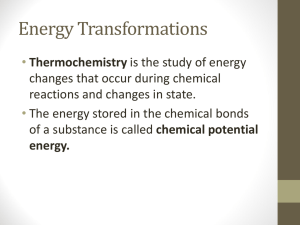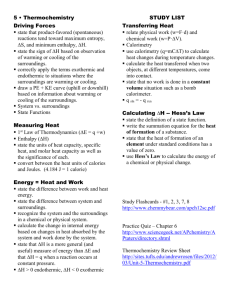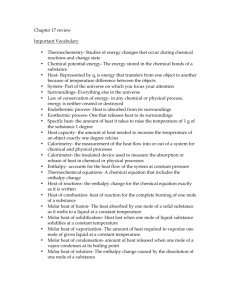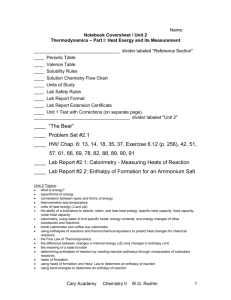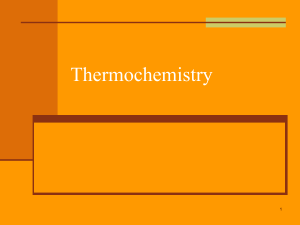Energy Transformations
advertisement
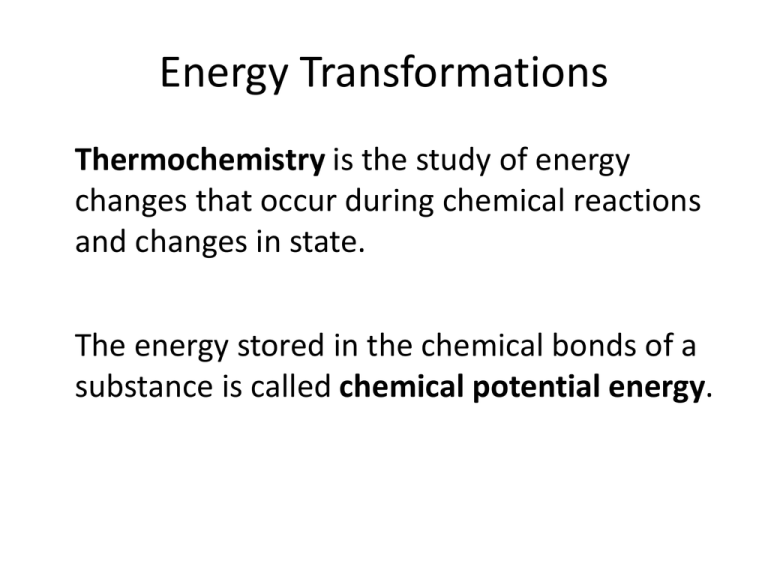
Energy Transformations Thermochemistry is the study of energy changes that occur during chemical reactions and changes in state. The energy stored in the chemical bonds of a substance is called chemical potential energy. Energy Transformations Heat, represented by q, is energy that transfers from one object to another because of a temperature difference between them. Heat always flows from a warmer object to a cooler object. Exothermic and Endothermic Processes In studying energy changes, you can define a system as the part of the universe on which you focus your attention. The surroundings include everything else in the universe. The law of conservation of energy states that in any chemical or physical process, energy is neither created nor destroyed. Exothermic and Endothermic Processes An endothermic process is one that absorbs heat from the surroundings. In an endothermic process, the system gains heat as the surroundings cool down. Exothermic and Endothermic Processes An exothermic process is one that releases heat to its surroundings. In an exothermic process, the system loses heat as the surroundings heat up. Units for Measuring Heat Flow A calorie is defined as the quantity of heat needed to raise the temperature of 1 g of pure water 1°C. The energy in food is usually expressed in Calories. Units for Measuring Heat Flow One joule of heat raises the temperature of 1 g of pure water 0.2390°C. The joule is the SI unit of energy. 1 J = 0.2390 cal 4.184 J = 1 cal Heat Capacity and Specific Heat The amount of heat needed to increase the temperature of an object exactly 1°C is the heat capacity of that object. Heat Capacity and Specific Heat The specific heat capacity, or specific heat, of a substance is the amount of heat it takes to raise the temperature of 1 g of the substance by 1°C. Heat Capacity and Specific Heat Calorimetry Calorimetry is the precise measurement of the heat flow into or out of a system for chemical and physical processes. In calorimetry, the heat released by the system is equal to the heat absorbed by the surroundings, and vice versa. Calorimetry The insulated device used to measure the absorption or release of heat in chemical or physical processes is called a calorimeter. Calorimetry The heat content of a system at constant pressure is the same as a property called enthalpy (H) of the system. Thermochemical Equations A chemical equation that includes the enthalpy change is called a thermochemical equation. In a chemical reaction, the enthalpy change for the reaction can be written as either a reactant or a product. Thermochemical Equations The heat of reaction is the enthalpy change for the chemical equation exactly as it is written. Thermochemical Equations The heat of combustion is the heat of reaction for the complete burning of one mole of a substance. Thermochemical Equations Heats of Fusion and Solidification The heat absorbed by one mole of a solid substance as it melts to a liquid at a constant temperature is the molar heat of fusion (ΔHfus). The molar heat of solidification (ΔHsolid) is the heat lost when one mole of a liquid solidifies at a constant temperature. ΔHfus = -ΔHsolid Heats of Vaporization and Condensation The amount of heat necessary to vaporize one mole of a given liquid is called its molar heat of vaporization (ΔHvap). The amount of heat released when 1 mol of vapor condenses at the normal boiling point is called its molar heat of condensation (ΔHcond). ΔHvap = -ΔHcond Heats of Vaporization and Condensation Heat of Solution During the formation of a solution, heat is either released or absorbed. The enthalpy change caused by dissolution of one mole of a substance is the molar heat of solution (ΔHsoln). Hess’s Law Hess’s law states that if you add two or more thermochemical equations to give a final equation, then you can also add the heats of reaction to give a final heat of reaction. Standard Heats of Formation The standard heat of formation (ΔHf°) of a compound is the change in enthalpy that accompanies the formation of one mole of a compound from its elements with all substances in their standard states at 25°C. Standard Heats of Formation

